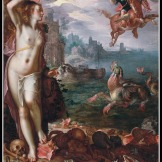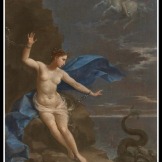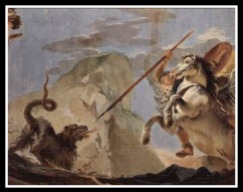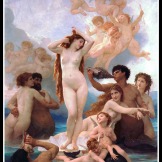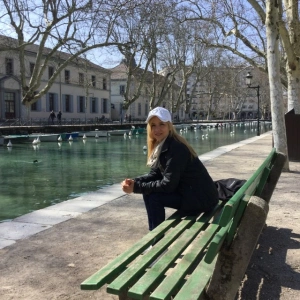



____________________________________________________________________________________________________________________
According to Plato, Beauty was an idea or Form of which beautiful things were consequence.
Beauty by comparison begins in the domain of intelligible objects, since there is a Form of beauty. The most important question is: what do all of these beautiful things have in common?. To know that is to know Beauty.
The Theory of Forms maintains that two distinct levels of reality exist: the visible world of sights and sounds that we inhabit and the intelligible world of Forms that stands above the visible world and gives it being. For example, Plato maintains that in addition to being able to identify a beautiful person or a beautiful painting, we also have a general conception of Beauty itself, and we are able to identify the beauty in a person or a painting only because we have this conception of Beauty in the abstract. In other words, the beautiful things we can see are beautiful only because they participate in the more general Form of Beauty. This Form of Beauty is itself invisible, eternal, and unchanging, unlike the things in the visible world that can grow old and lose their beauty.
Plato’s account in the Symposium connects beauty to a response of love and desire, but locate beauty itself in the realm of the Forms, and the beauty of particular objects in their participation in the Form.
Beauty’s distinctive pedagogical effects show why Plato talks about its goodness and good consequences, sometimes even its identity with “the good” (Laws 841c; Philebus 66a–b; Republic, 401c; Symposium 201c, 205e).
____________________________________________________________________________________________________________________
![]()

![]()
____________________________________________________________________________________________________________________
In Plato´ Symposium, Socrates claims to be quoting his teacher Diotima on the subject of love, and in her lesson she calls beauty the object of every love’s yearning.
She spells out the soul’s progress toward ever-purer beauty, from one body to all, then through all beautiful souls, laws, and kinds of knowledge, to arrive at beauty itself.
By going through these stages, one will ascend from loving particular kinds of beauty to loving Beauty itself, from which all beautiful things derive their nature.
Diotima suggests that a life gazing upon and pursuing this Beauty is the best life one can lead.
In the Symposium, the Form of Beauty is the final stage in the lover of knowledge’s ascent toward Beauty.
He begins by loving particular bodies, moving from there to bodies in general, to particular minds, to minds in general, to laws and practices, to knowledge, and finally to the knowledge of the Form of Beauty. The ascent is one of increasing generalization where one’s love of beauty comes to embrace more and more things.
Ultimately, however, one’s love of beauty will embrace only one thing, the Form of Beauty, but one will recognize in this Form all that is beautiful.
There is, besides, a sense of what Beauty may be: the signs of measure and proportion signal its presence and it is linked with goodness and justice.
Beauty here is conceived as perfect unity, or indeed as the principle of unity itself.
Plato´s Beauty Theory, as it appears in the Symposium, holds that the Beautiful is an objective quality which is more or less intensified in and exemplified by beautiful or less beautiful objects respectively. Beauty itself exists independently of the object’s relationship to a perceiver or of its being a means to some end.
The Beautiful, then, regardless of what it is, exists as a thing in itself, separate from and supreme in relation to the beautiful objects which are beautiful by somehow sharing in its being.
There is something innate and yet external to a beautiful object. Its beauty is there independently of a perceiver, and its being beautiful or not does not depend upon personal evaluations
Plato´s ideas could be considered as a sample of the prevailing classical conception.
According to it, Beauty consists of an arrangement of integral parts into a coherent whole, according to order, proportion and symmetry.
The ancient Roman architec Vitruvius gives as good a characterization of the classical conception in its underlying unity:
Order is the balanced adjustment of the details of the work separately, and as to the whole, the arrangement of the proportion with a view to a symmetrical result.
Proportion implies a graceful semblance: the suitable display of details in their context, when everything has a symmetrical correspondence.
Symmetry also is the appropriate harmony arising out of the details of the work itself: the correspondence of each given detail to the form of the design as a whole. (Vitruvius, 26–27)
Plato regarded beauty as objective in the sense that it was not localized in the response of the beholder.
In spite of Plato´s theories, we should now wonder if Beauty is an Universal Quality recognizable per se …
In other words… Is Beauty a relative assessment, which lies in the eye of the beholder…
If we believe so, then we should conclude that Beauty is created by a subjective judgment, in which each person determines whether something is beautiful or not.
If we agree with Plato, and therefore state that Beauty is pattern or form from which all beautiful things are derived, then we are assuming that Beauty is an objective feature.
By that our postulate would be that most perceivers would agree when it comes to determine whether something or someone is beautiful or not.
Without needing to take a side, we can say that it is both things…
Beauty couldn´t be entirely subjective—that is, if anything that anyone holds to be or experiences as beautiful is beautiful then it seems that the word has no meaning, or that we are not communicating anything when we call something beautiful except perhaps an approving personal attitude.
In addition, though different persons can of course differ in particular judgments, it is also obvious that our judgments coincide to a certain extent.
Either way, what we can certainly state is that our attraction to another person’s body increases if that body is symmetrical and in proportion.
In this sense, there are certain aesthetical features which might entail Beauty.
Scientists believe that we perceive proportional bodies to be more healthy. This is suggested in the following famous image showing an idealized human body within a square and a circle.
Leonardo da Vinci‘s drawings of the human body emphasized its proportion. The ratio of the following distances in the above Vitruvian Man image is approximately the Golden Ratio (Φ = 1.618033…).
With the math behind it, the symmetry of your face can be measured. The closer this number is to 1.618, the more beautiful it is…
____________________________________________________________________________________________________________________
![]()

The Golden Ratio (Φ = 1.618033…).
![]()

The Vitruvian Man, drawing by Leonardo Da Vinci, showing the body dimensiones, according to the Golden Ratio.
![]()
____________________________________________________________________________________________________________________

Following up with the previous philosophical introduction, I would like to bring to the spotlight a few greek mythological myths and certain thoughts, with regard to the idea of Beauty.
Firstly, the most well known case of the Judgement of Paris and the story of the Golden Apple of Discord.
The Judgement of Paris was a contest between the three most beautiful goddesses of Olympus–Aphrodite, Hera and Athena–for the prize of a golden apple addressed to “the fairest”.
While Paris inspected them, each of the goddess attempted with her powers to bribe him; Hera offered to make him king of Europe and Asia, Athena offered wisdom and skill in war, and Aphrodite, offered the world’s most beautiful woman.
On a side note, It is worth noting how mant times “Beauty” appears in this myth.
At the end, Paris chose Aphrodite, who was the Goddess of Love and Beauty, and Helen of Troy, who was considered the most beautiful woman, was bestowed on him, in exchange.
As to the beautiful Helen of Troy, she was also known as the face that launched a thousand ships, therefore somehow associated with features such as discord and betrayal.
The reason behind such reputation is that Helen of Troy was married by the time of the deal among the Prince of Troy and Aphrodite.
Hence Paris decided to abduct her, event which would eventually lead to the Trojan War…
In this sense, the Golden Apple was the biggest but also the most controversial prize. Besides and presumably, in the mythology surrounding “the Judgement of Paris”, the goddess of Discord Eris managed to enter The Garden of the Hesperides, which was Hera´s orchard, and plucked one of the fruits . We can therefore see why that golden apple go was also known as the Apple of Discord.
As to other quarrels originated due to similar smug assumptions involving Beauty, I would like to mention two cases, which are very similar when it comes to events and their consequences.
The first one features Myrrha, who was Adonis biological mother.
Myrrha’s mother had said that her daughter was even more beautiful than Aphrodite which angered the Goddess of Love, who cursed Myrrha to fall in love and lust after her father.
Thus, Myrrha became pregnant and gave birth to Adonis, who was raised by Aphrodite.
Adonis was very handsome, so, further on, Persephone was taken by his beauty, reason which brought a new quarrel among goddesses. In this case, between Aphrodite and Persephone.
Secondly, we have the well known myth of Perseus´beloved, Andromeda.
Her mother, Cassiopeia had offended the Nereids by boasting that Andromeda was more beautiful than they, so in revenge Poseidon sent a sea monster to ravage Andromeda´s father kingdom.
In all cases, Beauty causes troubles. We could say that it puts in the seeds of conflict.
Its counterpoint and collateral effect is jealousy. But also a sense of unnecessary pride and vanity seems to be present here.
Beauty claims to be defined in an extended way beyond itself… It needs to be recognized.
We could say that Beauty is defined by and to the Other.
Thus, in this order of ideas, we could think that Beauty seems to be an existentialist way to experience the Beautiful.
Intersubjectivity defines Beauty and the Other’s look constitutes the world and the beautiful as objective. This is because the Look tends to objectify what it sees.
Undoubtedly, there are subjective elements which help us define Beauty… But those ones, as Social Constructivists would state, are not necessarily individual but colective and cultural.
On the other hand, one can not deny that certain general and universal features, are linked to the idea of Beauty.
Therefore and figuratively speaking, I believe that Beauty would be a sui generis concept, constituted mainly by objective and intersubjective variables, which may vary according to time and contexts.
_________________________________________________________________________________________________________________________________________________________________

►Gallery: “Some Greek Myths based on Beauty”:
(Click on the images for further details)

_________________________________________________________________________________________________________________________________________________________________
►Playtime!:Is your face geometrically beautiful?:
Supposedly, when it comes to Beauty, the simplest measurement is the length of your face divided by the widest part of your face.
As previously mentioned above, the closer this number is to 1.618, i.e Golden Ratio, the more beautiful the person is…
There are countless ratios that can be measured, but the website Anaface will generate a computer calculation online of a few of these ratios, from your uploaded photo for free.
An important detail is that you ought to use the photograph URL. It didn’t work for me when I tried upload he image from my computer…
For that purpose, send yourself an email with the photograph and then copy paste its URL, as shown in the gallery.
Furthermore. keep in mind that the more horizontally your face is placed, the more reliable the results will be.
Use as a model the photograph provided in order to locate the points, especially if your ears don´t show up in the photograph due to your hair…
Follow up the instructions and you´ll soon get your score. Click on the images in the gallery below for further details …
__________________________________________________________________________________________________________________________________________________________


_______________________________________________________________________________________________________________________
►Last but not Least: Quote Challenge: Beauty:
Paul from Pal Fitness has nominated me for a so called 3-Day Quote Challenge. Please Check out Paul´s blog. He is a personal trainer and coach, who loves blogging and writing.
The rules of this challenge are: ♠Post your favorite quotes or your own quotes for three (3) posts in a row. ♠Thank the person who nominated you. ♠Pass it on to three (3) other bloggers per quote, each time you post them. Or pass it to nine (9) bloggers if you choose to post all the quotes together, in the same post.
⚠ Note: I will post the three (3) quotes together. Thus I will nominate nine (9) Bloggers.
Also, I thought It would be pertinent to choose quotes on Beauty, alongside photographs taken by me, which you will be able to see in my Instagram account... All this aims to keep it on with the topic of this post… So that’s how I will do it :D. If you have been nominated, feel free to join the challenge if you feel it is worth it, want to and/or have time to do so. You can to pick out whichever creative license regarding this feature.
My nominees for the Quote Challenge are: 1. D.G.Kaye Writer 2. Parlor of Horror 3. Course of Mirrors 4. Living the Dream 5. Solveig Werner 6. Scribble and Scrawl 7. Round World and Me 8. The Lonely Author 9. Aidyl93
►Three Quotes on Beauty by John Keats, and some Photographs:
~ Click on the images to read ~
__________________________________________________________________________________________________________
►Links Post:
http://www.iep.utm.edu/plato/
http://www.anaface.com/
https://en.wikipedia.org/wiki/Other
http://plato.stanford.edu/entries/beauty/#ClaCon
http://plato.stanford.edu/entries/plato-aesthetics/
http://asifoscope.org/2013/05/10/on-beauty/
http://www.intmath.com/blog/mathematics/is-she-beautiful-the-new-golden-ratio-4149
http://www.sparknotes.com/philosophy/plato/themes.html
http://www.sparknotes.com/philosophy/symposium/section11.rhtml
________________________________________________________________

_____________________________________________________


























